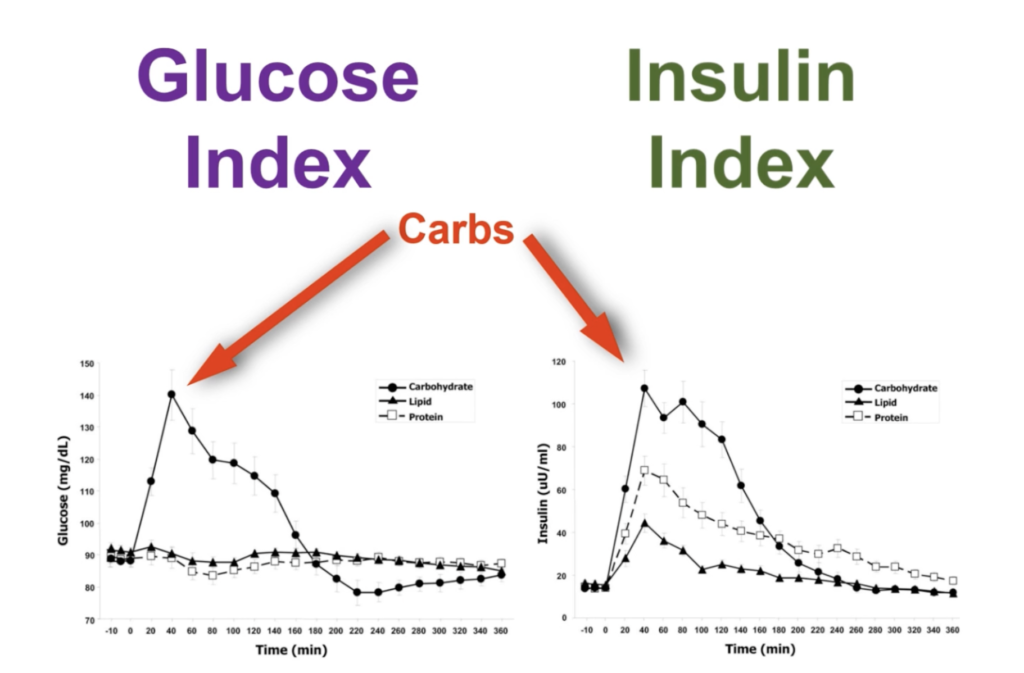Insulin
This post is all about insulin, what it is and what it does in the body. The information in this post won’t be addressing those with type 1 diabetes. Insulin is a hormone made by beta cells in the pancreas. Type 1 diabetes is an autoimmune condition that destroys those beta cells causing the pancreas to cease production of insulin. Type 1 diabetes is a condition that results from a lack of insulin and must be managed with prescribed insulin therapy. The information in this post is about the effect of too much insulin in the body. (1)
The primary functions of insulin:
- Nutrient Sensor: detects “energy” coming in from outside the body
- Inhibits the breakdown of stored energy (fat)
- Lowers blood sugar levels
Two Actions of Insulin:
- Excitatory – this means insulin does something, it stimulates cells to take in glucose (sugar) from the blood stream to form fat
- Inhibitory – this means insulin stops something, the breakdown of stored energy. Lipolysis is the breakdown of stored fat. Insulin inhibits lipolysis.
Imbalance Is The Problem
 Ding, ding, ding! It stops the breakdown of fat. I hope you all caught that. It may be hard to believe after that statement but insulin isn’t bad, we need it. Imbalanced insulin is bad. Insufficient amounts of insulin wastes the body away, and too much insulin causes weight gain, both of which happen regardless of diet and blood sugar levels. (2)
Ding, ding, ding! It stops the breakdown of fat. I hope you all caught that. It may be hard to believe after that statement but insulin isn’t bad, we need it. Imbalanced insulin is bad. Insufficient amounts of insulin wastes the body away, and too much insulin causes weight gain, both of which happen regardless of diet and blood sugar levels. (2)
Here’s the thing, insulin is an anabolic hormone. That means it promotes growth. Imbalanced insulin or high levels of insulin promote excess energy to be stored as fat. This brings us back to the primary jobs of insulin: a nutrient sensor, inhibitor of the breakdown of fat and a blood sugar regulator.
We all have body fat, that’s a good thing, we need it. The body can use stored fat as energy but NOT if insulin is high. If it is high we won’t breakdown stored body fat and we will continue to pack more energy away (more fat). When insulin senses energy coming in, food, it tells the body not to breakdown stored energy because the body can use the available energy that’s coming in. This seems like a good system and was when food was scarce but not today. We, as a people, eat more food on any given day than our body can use up as energy. So not only are we not breaking down stored energy we are packing away excess energy everyday as fat.
We are now back to blood sugar regulation. As insulin moves glucose out of the blood stream and stores it as energy (fat) the level of circulating glucose goes down. Regulating the amount of glucose in the blood (blood sugar levels) is a secondary action of energy storage. It’s not the primary job of insulin. The body doesn’t want super low blood sugar levels. If blood sugar were to drop to zero you would die, instantly. There are actually many systems in place to keep blood sugar levels up, glucagon for instance. Glucagon is another hormone made in the pancreas and it’s job is to keep blood sugar levels up.(3)
Think of fat as the bodies primary battery and sugar as the secondary battery. Believe it or not, the body prefers to run on fat. Fat is a 25% more efficient form of energy than sugar. You get 9 calories/gram of fat and only 4 calories/gram of sugar. Fat “burns” more cleanly meaning there are less toxic byproducts. In an ideal situation your body would run on fat and have stored glucose (backup) for quick bursts of energy in an emergency, like running from a bear or more realistically (for most of us) jumping out of the way of a speeding car.
That stored backup fuel is called glycogen and it’s stored in the liver and muscles. In a perfect world we would eat enough to replenish our glycogen stores, for ready energy in an emergency, with enough energy (calories) left over to burn during normal daily activity and nothing left to partition off to long-term fat storage. The problem is our glycogen stores are pretty small and fill up really quickly. Unless you’re doing a lot of high intensity exercise, daily, you aren’t burning through your glycogen stores and when those are full all that incoming energy you eat goes directly to fat storage. Think of fat storage as a long-term storage facility and glycogen as the closets in your home. If those closets are full you are going to have to keep shuttling more and more stuff to your long-term storage facility, not good. The other option, stop bringing stuff in and filling up storage space but that discussion is for an upcoming post.
O.k., so high levels of insulin are making us fat. Why do we have high levels of insulin. There are a couple of answers to that question. The food we eat promotes insulin secretion. The types of food we choose to eat will promote more or less insulin to be secreted. The amount of time we spend eating vs. not eating will have an effect on our over all insulin level. Stress will also affect insulin levels.
All macronutrients cause an insulin response. There is a lot of talk about carbohydrates and blood sugar levels. Of the macronutrients carbohydrates do cause the biggest insulin response, proteins would be next and then fats. Of the three, fats are the most negligible. Here’s the thing that I find particularly interesting. A blood sugar response is not the same as an insulin response. We hear a lot about the glycemic index and that we should eat foods low on the glycemic index to reduce our blood sugar response, keeping insulin low. The graph below is from a talk Dr. Ted Naiman did on insulin. (3) Notice that carbohydrates caused the greatest response on both the glucose and insulin index graphs. Protein and fat didn’t cause a glucose response but they did cause an insulin response. Protein caused about half the insulin response of carbohydrate and fat about half as much as protein. It’s all about insulin.
In the previous post I introduced you to the idea of a body weight set-point. You can also think of that as your body fat thermostat, the weight that your body is dialed into and will automatically try to maintain. The two parts of the equation that add up to your body weight set-point are your fasting insulin level + excess body weight. In my next post I’ll talk about insulin levels, insulin resistance and the basal insulin secretion rate or your fasting insulin level and how they all play a role in imbalanced body weight.
Part 1 – Weight Gain, is it Calories or is it Hormones
Part 2 – Body Weight Set Point
part 4 – The Problem with High Fasting Insulin
Part 5 – Macronutrients and Weight Loss
Part 6 – Not Enough Fat, Too Many Carbs
Part 7 – It’s the type of Calories that Count
References:
- http://www.diabetes.org/diabetes-basics/type-1/?referrer=https://www.google.com/
- http://www.ncbi.nlm.nih.gov/pubmed/24172304
- http://www.dietdoctor.com/hyperinsulinemia-insulin-body
- http://www.intensivedietarymanagement.com

I’m Amy a board certified holistic nutritionist, certified functional nutritionist and lifestyle practitioner and certified Life Coach. I help women in midlife understand the changing needs of their body so that they can stop dieting and lose weight permanently. At 56 I live what I teach. Don’t believe the story that your best years are behind you. They are not. Your best years are just starting!

